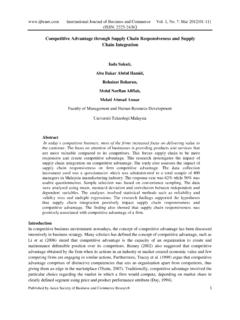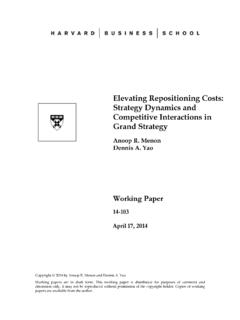Transcription of COMPETITIVE ADVANTAGE BY INTEGRATED E …
1 COMPETITIVE ADVANTAGE BY INTEGRATED E-BUSINESS IN SUPPLY CHAINS: A STRATEGIC APPROACH Reader PhD Gheorghe MILITARU University Politehnica Bucharest Reader PhD Daniel ERB NIC Academy of Economic Studies Bucharest Abstract: This paper reports findings of the COMPETITIVE ADVANTAGE of supply chain integration and the crucial role of INTEGRATED e-business to deliver those benefits. However, adoption of e-business in supply chains has been slower than expected, particularly in small to medium sized enterprises (SMEs). Differences between firms in supply chains and between supply chains are examined. Across industries, firms have adopted e-business initiatives to better manage their internal business processes as well as their interfaces with the environment. The authors findings provide the foundation for a more rigorous study of e-business.
2 Keywords: e-business, IT business value, supply chain management, value chain, COMPETITIVE ADVANTAGE Introduction Information technology today is a knowledge-capital issue. In this paper, authors think that a major role of information systems applications in business is to provide effective support of a company s strategies for gaining COMPETITIVE ADVANTAGE . This strategic role of information systems involves using information technology to develop products, services, and capabilities that give a company major advantages over the COMPETITIVE forces it faces in the global marketplace. In practice, this is accomplished through strategic information architecture. That is a collection of strategic information systems that support or shape the COMPETITIVE position and strategies of a business enterprise.
3 So a strategic information system can be any kind of information system (TPS, DSS, MIS, EIS, OAS, ERP etc.) that uses information technology to help an organization gain a COMPETITIVE ADVANTAGE , reduce a COMPETITIVE disadvantage, or meet other strategic enterprise objectives. The growth of interest in supply chain management is evident that integration is essential to supply chain management. COMPETITIVE ADVANTAGE is now derived from supply chains competing with other supply chains, not just firms with other firms (Marshall and Reibstein, 2001). In this case, issues related to e-business adoption and performance outcomes can be broadly viewed from the perspective of the consumer, suppliers, and of the supply chains. The adoption of e-business is of a continuous nature in the sense that the extent of its adoption across business processes may change with time.
4 In addition, not all aspects of e-business adoption may proceed in tandem. For example, a business may implement online sales, but not e-procurement. Furthermore, certain e-business initiatives are easy to adopt, whereas others may require substantial resources and/or organizational 28 restructuring. For example, e-procurement can call for compatible electronic data generation and exchange interfaces across businesses, substantial systems redesign and integration within those businesses, personnel training, and significant commitment from top management. When larger firms in supply chains attempt to impose e-business technologies on other members, SMEs do not have the skill or time to implement all the Intranet applications requested. Firm size also impacts on the level of resources available for investment in information technologies and associated training and education which can inhibit SME adoption.
5 Studies have highlighted that smaller businesses are often less aware of the full potential benefits of e-business. Beyond lack of awareness, SMEs have been shown to exhibit a greater uncertainty of the benefits of IT adoption than larger firms. We next review a conceptualization of e-business. Second, a framework that link the supply chain management, and information technology is presented. Third, the COMPETITIVE advantages obtain by integrating the e-business processes is discussed. It will present how the business can counter the threats of COMPETITIVE forces that they face by implementing the basic COMPETITIVE strategies and may obtain the COMPETITIVE advantages. E-business E-business uses the Internet technologies to link customers, suppliers, business partners, and employees using at least one of the following: (a) e-commerce websites that offer sales transactions, (b) customer-service websites, (c) intranets and enterprise information portals, (d) extranets and supply chains, and (e) IP electronic data interchange.
6 This definition is broadly consistent with the following: the use of electronic networks and associated technologies to enable, improve, enhance, transform or invent a business process or business system to create superior value for current or potential customers (Saehney and Zabin, 2001). Both definitions recognize that, by helping to build and manage relationships with customers, suppliers, employees, and partners, e-business can potentially transform a firm into a networked entity with supply chains and value creation processes (Saehney and Zabin 2001). Correspondingly, e-business has a impact across the entire span of the organization s structure from the procurement department to the field sales force and across a range of its business processes, from internal administration to supply-chain coordination.
7 In the context of communication processes, e-business tools facilitate information and knowledge flow within and across the boundaries of the business unit and can help integrate previously truncated information flows into a streamlined knowledge management system (Saehney and Zabin, 2001). However, knowledge is power and managers both within and across departments tends to gather rather than share information, thereby hindering the treatment of information as a shared, corporate asset. The Internet and related technologies and applications have change the way business are operated and people work, and how information systems support business processes, decision making, and COMPETITIVE ADVANTAGE . Thus, many businesses today are using Internet technologies to Web-enable business processes and to create innovative e-business applications.
8 See Figure 1. 29 We think that e-business use the Internet technologies to work and empower business processes, electronic commerce, and enterprise collaboration within a company and with its customers, suppliers, and other business stakeholders. In essence, e-business can be more generally considered an online exchange of value. The Internet and Internet-like networks inside the enterprise (intranet) and between an enterprise and its trading partners (extranet) have become the primary information technology infrastructure that supports the e-business applications of many companies. The Supply Chain Management Supply chain management (SCM) is a cross-functional interenterprise system that uses information technology to help support and manage the links between some of a company s key business processes and those of its suppliers, customers, and business partners.
9 The goal of SCM is to create a fast, efficient, and low-cost network of business relationships, or supply chain, to get a company s products from concept to market. Supply chain management (SCM) tracks inventory and information among business processes and across companies. Therefore, a supply chain management system is an IT system that supports supply chain management activities by automating the tracking of inventory and information among business processes and across companies. For example, in Figure 2 we can see the basic structure of supply chain. The goal of a comprehensive supply chain management system is to automate the flow of inventory and information across the entire supply chain. The organization would use electronic data interchange (EDI) the direct computer-to-computer transfer of transaction information contained in standard business documents, such as invoices and purchase orders, in a standard format to order needed inventory from various manufacturers.
10 Those electronic orders would trigger other systems within the manufacturing companies including the ordering of raw materials and parts from their suppliers and drop shipment schedules sent to the distributing lines. Likewise, when an end customer ordered furniture from a retail outlet, that retail outlet would communicate its needed inventory in similar fashion to manufacturing. To be effective and offer the greatest Figure 1. The Internet creates innovative e-business applications Company boundary The Internet Suppliers and other Business Partners Consumers and Business Customers Manufacturing and production Engineering and research Supply chain management: procurement, distribution, and logistics (SCM) Customer relationship management: marketing, sales, and customer service (CRM) Accounting and finance intranets extranets extranets 30 COMPETITIVE ADVANTAGE in the marketplace, all processes that move information would be handled in an automated fashion by EDI within an SCM system.








